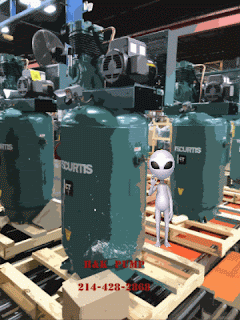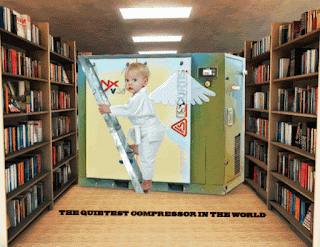 |
| The Dangers of Using PVC Piping for Air Compressor Systems |
WWW.HKAIRCOMPRESSORS.COM
214-428-2868
Air compressors are an essential tool in various industries, providing pressurized air for manufacturing, automotive repair, construction, and many other applications. Choosing the correct piping material for air compressor systems is critical to ensuring safety, efficiency, and longevity. While PVC (Polyvinyl Chloride) piping is a common and inexpensive material used for plumbing and irrigation, it is entirely unsuitable for compressed air applications. This essay explores the fundamental reasons why PVC piping should never be used for air compressor systems, focusing on the dangers of bursting, degradation over time, temperature sensitivity, pressure limitations, and regulatory concerns.
 |
| The Dangers of Using PVC Piping for Air Compressor Systems |
1. PVC’s Structural Weakness Under Compressed Air Pressure
PVC piping is commonly used for water transportation because of its affordability and ease of installation. However, water is an incompressible fluid, whereas air is highly compressible. This distinction is critical in understanding why PVC fails when subjected to compressed air systems. When an air compressor pressurizes the air, it stores significant potential energy within the piping network. PVC, while strong under liquid pressure, lacks the necessary durability to withstand the explosive nature of compressed air. If the pipe fails, it does not leak slowly like a cracked water pipe; instead, it bursts violently, creating dangerous flying debris that can injure personnel and damage equipment.
2. PVC Piping Can Degrade and Become Brittle Over Time
Another reason PVC is inappropriate for air compressor systems is its susceptibility to degradation. PVC is a thermoplastic, meaning it undergoes chemical and structural changes due to environmental factors, particularly exposure to ultraviolet (UV) radiation from sunlight. Over time, UV exposure weakens PVC, making it brittle and more prone to failure. In industrial settings, PVC piping is often installed in areas where it is exposed to light, dust, and chemicals that accelerate degradation. Even if initially installed properly, aging PVC pipes become vulnerable to cracking and sudden failure, posing a serious safety risk.
 |
| The Dangers of Using PVC Piping for Air Compressor Systems |
3. Temperature Sensitivity of PVC
PVC piping is highly sensitive to temperature fluctuations. While it may perform adequately in mild conditions, extreme temperatures can compromise its integrity. PVC pipes become increasingly brittle in cold environments, making them more susceptible to cracking or shattering upon impact or sudden pressure spikes. Conversely, in hot environments, PVC can soften and lose structural stability, increasing the risk of warping and bursting. Since air compressors generate heat during operation, the piping used must be able to withstand temperature variations without losing strength or flexibility. PVC fails in this regard, making it an unreliable option for air compressor systems.
 |
| The Dangers of Using PVC Piping for Air Compressor Systems |
4. Limited Pressure Ratings
Air compressors typically operate at relatively high pressures, with standard industrial systems running anywhere from 100 to 175 PSI (pounds per square inch). PVC piping does have pressure ratings, but these are typically designed for water applications rather than compressed air. Even Schedule 40 or Schedule 80 PVC pipes—the strongest available grades—struggle to handle sustained air pressure over time. When exposed to pressure beyond its tolerance, PVC experiences stress fractures, ultimately leading to catastrophic failure.
5. Regulatory and Safety Restrictions
Because of its inherent risks, PVC piping is prohibited for compressed air applications by major industry regulatory bodies and safety standards. Organizations such as the Occupational Safety and Health Administration (OSHA) and the American Society of Mechanical Engineers (ASME) explicitly warn against the use of PVC for compressed air. Many manufacturers also include warnings on PVC piping labels stating that it should not be used for air compressor applications. Ignoring these warnings not only puts individuals at risk but may also result in violations of workplace safety regulations, leading to legal and financial consequences.
 |
| The Dangers of Using PVC Piping for Air Compressor Systems |
WWW.HKAIRCOMPRESSORS.COM
214-428-2868
6. Alternative Piping Materials for Air Compressors
Since PVC is unsuitable for compressed air systems, professionals must explore better alternatives. Fortunately, various piping materials are specifically designed to handle the demands of compressed air applications. These include:
Black Iron Pipe – A traditional choice that is strong and durable but susceptible to rust and requires regular maintenance.
Copper Pipe – Highly resistant to corrosion and effective in handling compressed air pressure but costly.
Aluminum Pipe – Lightweight, non-corrosive, and relatively easy to install.
Stainless Steel Pipe – Extremely durable and corrosion-resistant but expensive.
PEX (Cross-linked Polyethylene) Pipe – Gaining popularity as a flexible and relatively safe alternative.
Galvanized Steel Pipe – Rust-resistant but still requires upkeep.
Each of these alternatives is far superior to PVC when it comes to handling pressurized air safely and efficiently.
.JPG) |
| The Dangers of Using PVC Piping for Air Compressor Systems |
Conclusion
While PVC piping is widely used in plumbing and irrigation, it is a dangerous and ineffective choice for compressed air applications. Its structural limitations, susceptibility to degradation, sensitivity to temperature changes, and inability to handle high air pressure make it a hazardous option. Industry standards and safety regulations strictly prohibit its use in air compressor systems due to the high risk of failure and potential harm to workers. Instead of PVC, professionals should use specialized materials such as aluminum, copper, or steel piping to ensure durability and safety. Making the right choice in piping materials is not just about efficiency—it is a matter of protecting lives and property.
 |
| The Dangers of Using PVC Piping for Air Compressor Systems |
WWW.HKAIRCOMPRESSORS.COM
214-428-2868
The Importance of Shutting Down Air Compressors During Electrical Storms
Electrical storms, commonly known as thunderstorms, are powerful natural phenomena that can pose significant risks to industrial equipment and workplace safety. Among the many pieces of machinery affected by severe weather, air compressors stand out due to their electrical components, pressurized systems, and potential for damage. This essay explores the reasons why air compressors should be shut down during an electrical storm, detailing concerns related to equipment protection, safety hazards, energy conservation, and compliance with industry best practices.
1. The Risk of Electrical Surges and Equipment Damage
During thunderstorms, lightning strikes can produce dangerous electrical surges. These surges occur when lightning directly or indirectly affects the power grid, sending sudden spikes of voltage through electrical systems. Air compressors, like other electrically powered devices, are vulnerable to such surges. A sudden voltage spike can overwhelm the compressor's circuitry, leading to blown fuses, damaged control panels, and even complete system failure.
Modern air compressors are often equipped with sensitive electronic components, including microprocessors that regulate pressure levels and efficiency. A lightning-induced power surge can destroy these components, leading to costly repairs or necessitating the replacement of the entire system. Shutting down and unplugging the compressor minimizes exposure to voltage spikes and protects the equipment from irreparable damage.
2. Preventing Fire Hazards and Explosions
Air compressors contain pressurized air, which can pose a significant hazard if the system malfunctions due to an electrical disturbance. A lightning strike has the potential to cause electrical shorts within the compressor, leading to overheating and fire hazards. Given that air compressors often operate in industrial environments with flammable materials present, a fire caused by electrical malfunctions can lead to catastrophic consequences.
Additionally, damaged compressors may experience sudden pressure buildup that, in extreme cases, can result in explosions. While rare, such incidents can cause severe injury to workers and extensive damage to the facility. Proactively shutting down air compressors during an electrical storm eliminates these risks and ensures workplace safety.
3. Protecting Personnel and Workplace Safety
Beyond equipment protection, ensuring the safety of employees is the most critical reason for shutting down air compressors during electrical storms. The presence of high-voltage electricity combined with pressurized air systems presents an increased risk to workers operating near these machines. A malfunctioning compressor can release unexpected bursts of air or debris, endangering anyone nearby.
Additionally, in cases where thunderstorms result in sudden power outages, compressors may stop abruptly and restart unpredictably. Employees working with or near the compressor might be caught off guard, leading to potential workplace injuries. Turning off the compressor before an electrical storm ensures that workers remain safe and eliminates unpredictable machine behavior.
4. Preventing System Downtime and Costly Repairs
A damaged air compressor can bring an entire production process to a halt. In industries where compressed air is essential for operations—such as manufacturing, automotive repair, and construction—the failure of a compressor due to an electrical surge can lead to costly delays. Repairing or replacing a damaged compressor requires time and financial resources, impacting business profitability.
By shutting down air compressors before an electrical storm arrives, businesses can avoid unplanned downtime and costly repairs. Preventative action ensures that machinery remains intact and operational once the storm has passed.
5. Energy Conservation and Efficiency
Operating air compressors during a thunderstorm can lead to energy inefficiencies and unnecessary power consumption. If lightning strikes cause fluctuations in electrical currents, compressors may operate under irregular conditions, leading to energy waste and reduced efficiency. Additionally, in cases where power outages occur, running a compressor during intermittent disruptions can cause frequent restarts, increasing wear and tear on the equipment.
Shutting down compressors during severe weather ensures that energy is not wasted on inefficient operation. Businesses can save electricity, reduce utility costs, and maintain optimal equipment functionality by proactively managing power use during storms.
6. Compliance with Industry Safety Standards
Various regulatory bodies emphasize the importance of safe equipment operation during severe weather conditions. Organizations such as the Occupational Safety and Health Administration (OSHA) and the National Fire Protection Association (NFPA) provide guidelines on protecting electrical machinery and industrial equipment from storm-related damage.
Businesses that fail to implement safety measures during electrical storms may be held liable for workplace injuries or equipment failures. Compliance with industry safety standards is essential for legal protection, ensuring that operations adhere to best practices.
7. Steps to Take Before and After an Electrical Storm
To maximize safety and equipment protection, businesses should follow a structured approach when dealing with thunderstorms:
Before the Storm:
Monitor weather forecasts and prepare for incoming storms.
Shut down and unplug air compressors to prevent electrical surges.
Inform workers about storm-related safety procedures.
Inspect compressor components to ensure proper shutdown protocols.
After the Storm:
Conduct a thorough equipment inspection before restarting the compressor.
Check for electrical issues, damaged fuses, or malfunctioning controls.
Ensure power stability in the facility before reactivating machinery.
Perform routine maintenance to confirm the compressor's integrity.
Conclusion
Turning off air compressors during an electrical storm is a critical safety measure that protects equipment, personnel, and business operations. Electrical surges, fire hazards, workplace injuries, and costly repairs are all preventable through proactive shutdown procedures. By prioritizing equipment safety and adhering to industry best practices, businesses can ensure uninterrupted operations while mitigating risks associated with severe weather. The simple act of shutting down air compressors before a storm can make a profound difference in preventing damage and safeguarding industrial environments.
.PNG)
.PNG)
.PNG)

















.JPG)





























